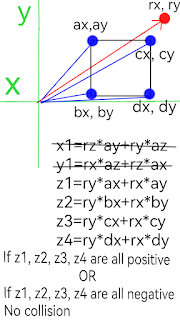V P U
Just thinking about a hypothetical "VPU", or Voxel Processing Unit.
It would only require 16 instructions:
NOT - bitwise NOT of register.
OR - bitwise OR of register.
AND - bitwise AND of register.
ADD - register addition with register.
SUB - register subtraction with register.
MUL - register multiplied with register.
RS11 - right shift register 11 bits.
RS13 - right shift register 13 bits.
RS8 - right shift register 8 bits.
ZSUB - zero subtracted from register.
AND255 - register AND 255.
256SUB - 256 subtracted from register.
ADD256 - 256 added to register.
SUB256 - register subtracted 256.
JELZ - jump if equal or less than zero.
JEGZ - jump if equal or greater than zero.
A total of 23 variables are used in calculations so they could be loaded into a 32 general register system at the start with a final pixel colour returned.
Alternatively a RISC-V approach can be taken. First registers are constants:
register0 = 0
register1 = 256
register2 = 255
register3 = 8
register4 = 11
register5 = 13
register6 - 31 = variables.
This way every instruction involves two registers, thus making next instruction logistics easier.
Now there are only 9 instructions.
NOT, AND, OR, ADD, SUB, MUL, RS, JELZ, JEGZ.
Adding a POPCOUNT instruction will allow me to decompress terrain data at a ratio of 32:1 in realtime! Big thanks to high school friend Daniel Dennett for that breakthrough.
This only works for integer based systems:
Move the heightmap right one pixel. Subtract this heightmap from the original to give this:
Select the dark area and fill with red, invert the selection and fill with blue:
Black pixel = add 0
Red pixel = add +1
Blue pixel = add -1
If travelling in the opposite direction:
Black pixel = add 0
Red pixel = add -1
Blue pixel = add +1
Over 90% of this heightmap is one bit data. The relative data allows for run length encoding if more compression is needed.
Now I can run 32 threads and not worry about going over the browsers 1.5 GB memory limit. I can also run 8 Orange Pi Zero 3 microcontrollers for a $160, 32 thread machine.
The best thing about voxels is I can do a "3d" BitBLT. This allows me to perform some really cool effects, that are simple to implement and are on a massive scale. I can also simulate a 3d page flipping system by superimposing two worlds on top of each other. By changing a single bit I can perform a pseudo 3d flip instantaneously.
In 2004 when I was exploring uses for "world flipping" I envisioned a time travel effect similar to the Doom "melt" effect. Replacing the current 3d world with a future 3d world. Just finished watching Silent Hill on DVD and realised I could easily replicate the school morphing into the coal mine with a simple Cellular Automaton. Only just scratching the surface of voxel power.
Because this has been a 30 year hobby,the cost of running 8 machines per year is $100.
Just finished one hour testing batches on a dimensity 7020. Running 5 threads at 100% used 8% battery charge with no drop in performance. The phone remained at room temperature for the whole hour. Extremely good results, no more testing required. The space leaper is a rough approximation and the actual space leaping system could yield another 50% performance boost.
Moving the iso-surface extractor out of the renderer for a non-multiply 3D rendering engine. This will reduce the number of variables in the renderer and reduce garbage collection. Javascripts window.location.replace function has given me a theoretically infinite number of 3D engines, all I have to do is copy the file and rename it. Change the name of the image file and I have just created a new 3D world and all the 3D models. This is the best thing about javascript, I love it! Just finishing "mo-cap" library with $200 phone!










Comments
Post a Comment